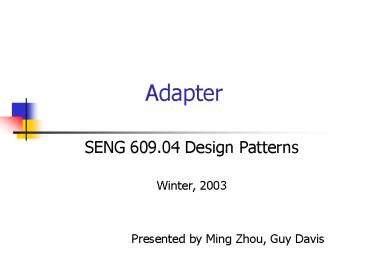Adapter - PowerPoint PPT Presentation
1 / 17
Title:
Adapter
Description:
Change the interface of a class into another interface which is expected by the client. ... http://www.javaworld.com/javaworld/jw-05-1999/jw-05-networked.html ... – PowerPoint PPT presentation
Number of Views:22
Avg rating:3.0/5.0
Title: Adapter
1
Adapter
- SENG 609.04 Design Patterns
- Winter, 2003
- Presented by Ming Zhou, Guy Davis
2
Agenda
- Intent Motivation
- Structure
- Applicability
- Consequences
- Known Uses
- Related Patterns
- References
3
What is Adapter?
- Change the interface of a class into another
interface which is expected by the client. - A.K.A. Wrapper
4
Motivation
5
Structure (Class)
6
Structure (Object)
7
Applicability
- Use an existing class whose interface does not
match the requirement - Create a reusable class though the interfaces are
not necessary compatible with callers
8
Class Adapter Pattern
- Pros
- Only 1 new object, no additional indirection
- Less code required than the object Adapter
- Can override Adaptee's behaviour as required
- Cons
- Requires sub-classing (tough for single
inheritance) - Less flexible than object Adapter
9
Object Adapter Pattern
- Pros
- More flexible than class Adapter
- Doesn't require sub-classing to work
- Adapter works with Adaptee and all of its
subclasses - Cons
- Harder to override Adaptee behavior
- Requires more code to implement properly
10
Pluggable Adapters
- implemented with abstract operations
11
Pluggable Adapters
- implemented with delegate objects
12
Two-way Adapters
class PegAdapter public SquarePeg, RoundPeg
public void virtual roundPegOperation()
add some corners
squarePegOperation() void virtual
squarePegOperation() add some
corners roundPegOperation()
- class SquarePeg
- public
- void virtual squarePegOperation() blah
class RoundPeg public void virtual
roundPegOperation() blah
13
Adapting Local Classes to RMI
- Comparison
- Increases reusability of local class
- Improves performance of local class
- Doesn't use Java single parent by subclassing
(uses composition)
14
Related Patterns
- Adapter can be similar to the remote form of
Proxy. However, Proxy doesn't change interfaces. - Decorator enhances another object without
changing its interface. - Bridge similar structure to Adapter, but
different intent. Separates interface from
implementation.
15
Conclusions
- Allows collaboration between classes with
incompatible interfaces - Implemented in either class-based (inheritance)
or object-based (composition delegation) manner - Useful pattern which promotes reuse and allows
integration of diverse software components
16
References
- Becker, Dan. Design networked applications in RMI
using the Adapter design pattern. JavaWorld
Magazine, May 1999. http//www.javaworld.com/javaw
orld/jw-05-1999/jw-05-networked.html - Buschmann et al. A System of Patterns
Pattern-Oriented Software Architecture. John
Wiley and Sons. Chichester. 1996 - Gamma et al. Design Patterns Elements of
Reusable Object-Oriented Software.
Addison-Wesley. Boston. 1995 - Nguyen, D.X. Tutorial 10 Stacks and Queues The
Adapter Pattern. Rice University. 1999.
http//www.owlnet.rice.edu/comp212/99-fall/tutori
als/10/tutorial10.html - Whitney, Roger. CS 635 Advanced Object-Oriented
Design Programming. San Diego State University.
2001. http//www.eli.sdsu.edu/courses/spring01/cs6
35/notes/proxy/proxy.htmlHeading10 - Shalloway, Alan., and Trott, James R., Design
Patterns Explained A New Perspective on
Object-Oriented Design, Addison-Wesley, 2002. - Rising, Linda., The Patterns Handbook
Techniques, Strategies, and Applications,
Cambridge university Press, 1998.
17
Questions?

